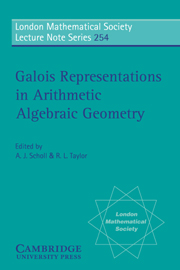Book contents
- Frontmatter
- Contents
- Preface
- List of participants
- Lecture programme
- 1 The Eigencurve
- 2 Geometric trends in Galois module theory
- 3 Mixed elliptic motives
- 4 On the Satake isomorphism
- 5 Open problems regarding rational points on curves and varieties
- 6 Models of Shimura varieties in mixed characteristics
- 7 Euler systems and modular elliptic curves
- 8 Basic notions of rigid analytic geometry
- 9 An introduction to Kato's Euler systems
- 10 La distribution d'Euler-Poincaré d'un groupe profini
6 - Models of Shimura varieties in mixed characteristics
Published online by Cambridge University Press: 23 March 2010
- Frontmatter
- Contents
- Preface
- List of participants
- Lecture programme
- 1 The Eigencurve
- 2 Geometric trends in Galois module theory
- 3 Mixed elliptic motives
- 4 On the Satake isomorphism
- 5 Open problems regarding rational points on curves and varieties
- 6 Models of Shimura varieties in mixed characteristics
- 7 Euler systems and modular elliptic curves
- 8 Basic notions of rigid analytic geometry
- 9 An introduction to Kato's Euler systems
- 10 La distribution d'Euler-Poincaré d'un groupe profini
Summary
Introduction
At the 1996 Durham symposium, a series of four lectures was given on Shimura varieties in mixed characteristics. The main goal of these lectures was to discuss some recent developments, and to familiarize the audience with some of the techniques involved. The present notes were written with the same goal in mind.
It should be mentioned right away that we intend to discuss only a small number of topics. The bulk of the paper is devoted to models of Shimura varieties over discrete valuation rings of mixed characteristics. Part of the discussion only deals with primes of residue characteristic p such that the group G in question is unramified at p, so that good reduction is expected. Even at such primes, however, many technical problems present themselves, to begin with the “right” definitions.
There is a rather large class of Shimura data—those called of pre-abelian type—for which the corresponding Shimura variety can be related, if maybe somewhat indirectly, to a moduli space of abelian varieties. At present, this seems the only available tool for constructing “good” integral models. Thus, if we restrict our attention to Shimura varieties of pre-abelian type, the construction of integral canonical models (defined in §3) divides itself into two parts:
Formal aspects. If, for instance, we have two Shimura data which are “closely related”, then this should have consequences for the existence of integral canonical models. Loosely speaking, we would like to show that if one of the two associated Shimura varieties has an integral canonical model, then so does the other. Most of such “formal” results are discussed in §3.
- Type
- Chapter
- Information
- Galois Representations in Arithmetic Algebraic Geometry , pp. 267 - 350Publisher: Cambridge University PressPrint publication year: 1998
- 30
- Cited by



